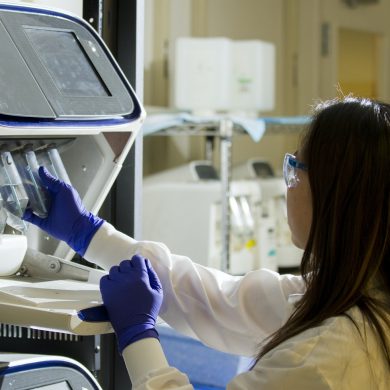By Humphrey Lin | Staff Writer | SQ Online (2013-2014)
Being an undergraduate researcher at an academic biology lab can be quite intimidating. Surrounded by world-class scientists and Nobel Prize winners, it can be hard to see how someone without experience or a degree can contribute significantly to the research. How much can a student really contribute to the scientific community? The answer: a lot more than one might think. In 1997, undergraduate researcher Dino Elyassnia joined Dr. Raffi Aroian’s then newly-established lab at UC San Diego. Elyassnia’s work, though unbeknownst to either one at the time, would eventually change the lab’s direction and launch a new line of research.
Many students will recognize Dr. Aroian’s lab as one of the leading research groups of cures for parasitic worms. This, however, was not always the lab’s research focus.
“At the time…we were not looking for a new cure for worms,” Dr. Aroian said. “From [Elyassnia’s] point of view, he was working on a crystal protein.”
Crystal proteins are proteins that come from a soil bacteria called Bacillus thuringiensis. They have been used extensively since the 1960’s as the insecticide of choice for organic farmers because they are harmless to vertebrates. Due to their widespread use and importance to agriculture, there was much interest in researching how the crystal proteins work. Elyassnia, who entered Dr. Aroian’s lab through a personal recommendation by the Revelle College provost at the time, proceeded to tackle this work, not knowing the massive impact his research would eventually have.
To study protein mechanisms, the researchers used nematodes, which are killed by crystal proteins similar to the ones that kill insects.
“Dino’s project was basically to take that crystal protein, and to study how it works.” Dr. Aroian said. “What he did was mutate C. Elegans, and looked for mutants that are resistant to the protein.”
Dino performed a genetic screen to find all the mutants that were resistant to the harmful effects of this protein, and then put these mutants into complementation groups. Working together with a technician in the lab, he published a paper on which he was co-first author.
Publishing a scientific paper as an undergraduate is already hard to achieve. Elyassnia’s research, however, held even larger implications for the lab and for the scientific community. It would pave the way for the usage of crystal proteins as treatment for intestinal worms. Years later, a researcher from Ohio State University mentioned to Dr. Aroian that worms are a huge health issue, and that the research headed by Elyassnia’s work could lead to a solution.
“Dino’s work really got the research off the ground,” Dr. Aroian said. “It’s hard to say where we’d be right now without this initial project.”
Treatment of intestinal worms using crystal proteins is now one of the primary focuses of the Aroian lab. Their research has contributed much to the development of novel treatment drugs, and their lab is one of the leaders of the field. Since Elyassnia’s contribution, Dr. Aroian has had many undergraduates work in his lab, many of whom have participated in research projects and have published their findings.
“Hard work–there’s no substitute for it,” Dr. Aroian said. “Showing up, being focused, and working hard makes these students successful.”
It may be hard for an undergraduate to imagine the type of impact he or she is able to make, but as in Elyassnia’s example, even a student can make an immense difference through his or her devotion to science and research. UCSD Biological Sciences offers many unique opportunities for undergraduates to become involved in science, and Elyassnia’s story is a testament to the significance of such opportunities.
